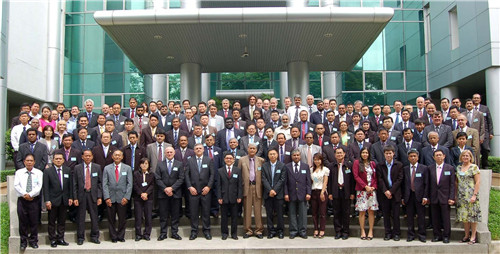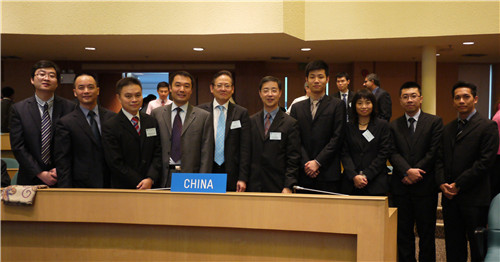
 {{_.$tools.formatDate(item.publishTime, 'yyyy-MM-dd')}} {{item.title}}
{{_.$tools.formatDate(item.publishTime, 'yyyy-MM-dd')}} {{item.title}} 
Civil Aviation Authority actively cooperates with International Civil Aviation Organization and Asia Pacific aeronautical authorities to enhance regional aviation safety

Civil Aviation Authority actively cooperates with International Civil Aviation Organization and Asia Pacific aeronautical authorities to enhance regional aviation safety 2013-07-02
The Civil Aviation Authority of Macao SAR (AACM) participated in the “24th Meeting of the Asia Pacific Air Navigation Planning and Implementation Regional Group (APANPIRG)” and the “3rd Meeting of the Regional Aviation Safety Group - Asia Pacific (RASG-APAC)” held in Bangkok from 24 to 28 June 2013 to discuss with the International Civil Aviation Organization (ICAO) and the aeronautical authorities of other Asian Pacific countries about the work items for the coming year.
The APANPIRG is an annual meeting in the Asia Pacific Region with the objective of allowing attendees to discuss about the enhancement of operation safety through further improving the facilities and procedures in four main issues, namely the air traffic management, airspace safety monitoring, communication/navigation/surveillance systems, and meteorology. The 24th Meeting was held from 24 to 26 June 2013, during which AACM took part in the Air Traffic Management Sub-group and the Communication/Navigation/Surveillance Systems Sub-group. In the Air Traffic Management Sub-group, the Aerodrome Operations and Planning Working Group which is a subsidiary of the said Sub-group, was chaired by the Director of Airport Infrastructure and Air Navigation of AACM, Mr. Kevin Lam, who was elected to be the chairperson of this Working Group in this May.
The Aerodrome Operations and Planning Working Group was attended by more than 40 delegates from over 20 states/administrations or international organizations. The Working Group adopted the following decisions: in the area of airport pavement operation, ICAO will provide the definition of “unrestricted operations” in the relevant guidance material; in the area of runway safety, the aeronautical authorities will work together with their airports to establish runway safety teams and runway safety programmes; in the area of aerodrome certification, the Working Group urged states/administrations who have not yet implemented the requirements of aerodrome certification and safety management systems to do so as high priority; in the area of creating clearance for aircraft at an airport, ICAO will carry out study on the provision of guidance material for vertical clearance between an aircraft and an object on aircraft stands; in the area of obstacle limitation surfaces, ICAO will take into reference the advancement of air navigation systems and the need for land use optimization to review the obstacle limitation surfaces requirements and amend when necessary to cope with the development of the air transport businesses in Asia Pacific. Being the chairman of the Meeting, AACM will put its best endeavours in the four-year chairmanship to coordinate with the other members to aim for the betterment of air navigation services in Asia Pacific.
The 3rd RASG-APAC was held from 27 to 28 June 2013 and attended by more than 100 participants from over 30 states/administrations or international organizations. The Meeting came up with 24 decisions, including the conclusion of the guidance materials for controlled flight into terrain, loss of control in flight, runway excursions and incursions, and so on. In addition, the new Global Aviation Safety Plan which was approved by the ICAO Council in this May was also introduced in the Meeting. The new Global Aviation Safety Plan aims at providing a performance framework and assistance to ICAO’s member states and administrations, the airlines worldwide and the Aviation Safety Groups in Asia Pacific, Pan American Region, Europe, Middle East and Africa, in their formulation of the aviation safety plans. The Meeting discussed how the RASG-APAC should define their safety priorities and targets in compliance with this new Plan and agreed that the follow-up work of such compliance would be a task item for the coming year.
In 2012, AACM cooperated with the Civil Aviation Authority of Singapore to write the working paper on “Sharing of Information on Potential Precursors to Air Accidents” which was already presented and approved in the 2nd RASG-APAC. The 3rd Meeting concluded the follow-up task of this working paper by assigning the Safety Reporting and Programme Ad hoc Working Group to be the focal group for matters relating to this task and to provide data analysis capabilities.
AACM wishes to state that aviation is a highly international industry. The stable development of the air transport services between two places requires the safe operation of both places to achieve at the same standard. Therefore, the aviation safety policy of Macao does not only focus on internal monitoring within its own Special Administration Region. AACM ensures that all aviation activities under Macao’s jurisdiction comply with Macao’s aviation laws and regulations and the international standards. At the same time, AACM also wishes to collaborate with ICAO and other aeronautical authorities, or through technical assistance rendered to each other, to work together to enhance the entire aviation safety level in Asia Pacific.
Being a counterpart in Asia Pacific, Macao actively participates in the various working groups or task forces motivated by ICAO. Macao takes the notion that through sharing of resources, Macao can exchange information with foreign experts or render consultancy service to other states that require it, hence making bigger contribution to aviation safety enhancement in Asia Pacific .

The Civil Aviation Authority of Macao SAR attended the “24th Meeting of the Asia Pacific Air Navigation Planning and Implementation Regional Group” held in Bangkok from 24 to 26 June 2013 to discuss with the International Civil Aviation Organization and the other aeronautical authorities of Asia Pacific on the enhancement of the planning of air navigation services in the Region.

The aeronautical authorities of mainland China, Hong Kong and Macao participated in the “3rd Meeting of the Regional Aviation Safety Group - Asia Pacific” held in Bangkok on 27 and 28 June 2013 to discuss with the aeronautical authorities of the other Asian Pacific countries about the future work items for the enhancement of aviation safety in the Region.
























